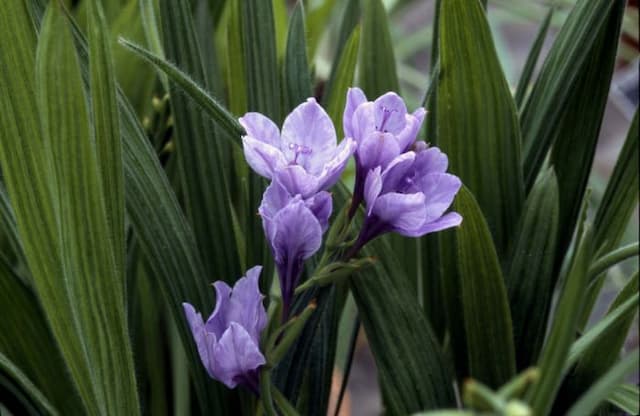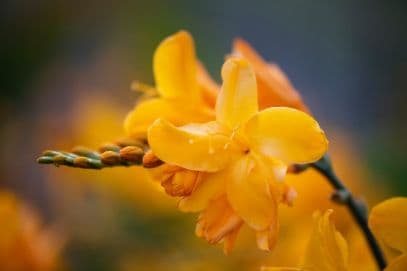New Zealand Iris Libertia grandiflora (R. Br.) Sweet

ABOUT
Libertia grandiflora, commonly known as largeflower libertia, is a perennial plant known for its attractive and distinctive appearance. It features a clump-forming habit, with upright, sword-shaped leaves that create an almost grass-like tuft. The foliage can have an eye-catching, green coloration that may turn to appealing orange-brown hues in colder months, adding seasonal interest. Spring and early summer see the emergence of elegant flowering stems that rise above the foliage, adorned with numerous large, pure white flowers. These blossoms are star-shaped and give the plant a delicate and airy look, which can be quite striking in a garden setting. The flowers eventually give way to seed capsules that add further ornamental value. Largeflower libertia's refined form and blossoms make it an appealing choice for gardeners looking to imbue their landscapes with a touch of natural beauty and attract pollinators.
About this plant
 Names
NamesSynonyms
New Zealand Iris, Tukauki, Mikoikoi
Common names
Libertia ixioides var. grandiflora R. Br., Sisyrinchium grandiflorum (R. Br.) Kuntze
 Toxicity
ToxicityTo humans
Libertia grandiflora, commonly known as New Zealand Iris, is not widely recognized as a toxic plant to humans. There is limited information readily available regarding its toxicity, suggesting that it is not commonly associated with human poisoning. Consequently, there are no well-documented symptoms of poisoning by ingestion of this plant for humans. However, as with any plant, individual allergies or sensitivities could potentially cause reactions, so caution should be exercised when handling unknown plants.
To pets
Libertia grandiflora, commonly referred to as New Zealand Iris, is not generally known for being toxic to pets. There is no widespread documentation or reports suggesting that pets, such as dogs and cats, are at risk of poisoning from ingesting parts of this plant. Nonetheless, it is always prudent to prevent pets from eating plants not intended for consumption, as individual animals might have reactions to plants that are non-toxic to most.
 Characteristics
CharacteristicsLife cycle
Perennials
Foliage type
Evergreen
Color of leaves
Green
Flower color
White
Height
2 feet (0.61 meters)
Spread
2 feet (0.61 meters)
Plant type
Herb
Hardiness zones
8
Native area
Australasia
Benefits
 General Benefits
General Benefits- Ornamental value: Libertia grandiflora, commonly known as New Zealand iris, is valued for its attractive form, foliage, and flowers that enhance garden aesthetics.
- Low maintenance: It is relatively easy to care for, requiring minimal attention once established, making it a suitable choice for low-maintenance landscapes.
- Drought tolerance: New Zealand iris is tolerant of dry conditions, making it an appropriate selection for water-wise gardens and regions experiencing water restrictions.
- Wildlife attraction: The flowers provide nectar and attract pollinators like bees, supporting local ecosystems.
- Year-round interest: With evergreen foliage and striking flower spikes, it provides visual interest throughout the year.
- Erosion control: The plant's root system can help stabilize soil, reducing erosion on slopes and banks.
- Tolerant of various soils: New Zealand iris can grow in a range of soil types, from sandy to loamy, as long as the soil is well-draining.
- Versatile landscaping: It can be used in mixed borders, as a focal point, or in mass plantings, offering versatility in garden design.
- Frost hardy: It can withstand light frosts, making it suitable for gardens in cooler climates.
 Medical Properties
Medical PropertiesThis plant is not used for medical purposes.
 Air-purifying Qualities
Air-purifying QualitiesThis plant is not specifically known for air purifying qualities.
 Other Uses
Other Uses- Libertia grandiflora, commonly known as New Zealand iris, can be used for its strong, fibrous leaves in basket weaving, providing material with a unique texture and color.
- The New Zealand iris's clumping habit and rhizomatous root system make it suitable for erosion control on banks and slopes.
- The flowers of the New Zealand iris provide nectar for pollinators, making it a useful garden addition for supporting local bee populations.
- Its striking white blooms and stiff foliage can be used in floral arrangements, where they can provide both structure and a delicate aesthetic.
- The stiff and upright leaves can be utilized in garden design for creating striking vertical elements and contrast with softer, rounded plant forms.
- Libertia grandiflora can be used as an ornamental water garden plant, its structure and form adding aesthetic value around ponds and water features.
- Its distinctive seed pods add interest to the winter garden and can be used as a natural decoration in winter bouquets or displays.
- In areas with milder climates, New Zealand iris serves as a year-round green presence, offering visual interest in minimalist or contemporary garden designs.
- It can be planted as a ground cover where low maintenance is desired, as it forms dense clumps which suppress weeds effectively.
- The plant's tolerance for coastal conditions makes it an excellent choice for seaside gardens, helping to stabilize sandy soils and contribute to the local ecosystem.
Interesting Facts
 Feng Shui
Feng ShuiThe Libertia grandiflora, commonly known as New Zealand iris, is not typically used in Feng Shui practice.
 Zodiac Sign Compitability
Zodiac Sign CompitabilityThe New Zealand iris is not used in astrology practice.
 Plant Symbolism
Plant Symbolism- Persistence: Libertia grandiflora, commonly known as New Zealand iris, often signifies persistence due to its robust nature and capability to withstand various environmental conditions.
- Adaptability: The adaptability of this plant to different landscapes embodies flexibility and the ability to thrive in diverse situations.
- Purity: The white blossoms of the New Zealand iris represent purity and innocence, often used in floral arrangements to convey clarity and simplicity.
- Freedom: With its upright, sword-like leaves, it can symbolize freedom and the spirit of independence, standing tall and untethered.
 Water
WaterThe New Zealand iris, commonly known as Libertia grandiflora, prefers consistent moisture but well-drained soil to prevent root rot. Watering should be done deeply to ensure that the moisture reaches the roots, approximately once a week, depending on the climate and soil conditions. During the growing season in spring and summer, ensure it receives about 1 gallon of water per week, especially if the weather is dry. In the fall and winter, you can reduce the frequency of watering as the plant's growth slows down. Adjust the amount and frequency of watering based on rainfall, as too much water can be as detrimental as too little.
 Light
LightThe New Zealand iris thrives in full sun to partial shade. A spot that receives at least six hours of direct sunlight is ideal for promoting healthy growth and flowering. It can also tolerate some shade, particularly in the afternoon when the sun is strongest, but too much shade can lead to weak growth and fewer flowers. Choose a location that is sheltered from strong winds but still receives ample sunlight.
 Temperature
TemperatureThe New Zealand iris is quite hardy and can tolerate a range of temperatures. It can survive in conditions as cold as 20 degrees Fahrenheit and as high as 90 degrees Fahrenheit. However, the ideal temperature for this plant is between 60 and 75 degrees Fahrenheit. As a native to New Zealand, it can tolerate some light frost, but it is important to protect it from prolonged freezing temperatures to avoid damage to the plant.
 Pruning
PruningPruning the New Zealand iris is mainly focused on maintaining plant health and aesthetics. It's best to prune in late winter or early spring by removing any dead or damaged leaves to encourage new growth. This plant does not require heavy pruning, but light trimming can help to keep a tidy appearance and encourage bushier growth. Pruning immediately after flowering can help to stimulate a second bloom.
 Cleaning
CleaningAs needed
 Soil
SoilNew Zealand Iris prefers well-drained soil with a mixture of loam, peat, and sand to promote aeration and drainage. It thrives best in soil with a pH range of 5.5 to 7.0. Amend with organic matter to boost fertility.
 Repotting
RepottingNew Zealand Iris does not need frequent repotting; do it every 2-3 years or when it's root-bound. Best repotted in spring.
 Humidity & Misting
Humidity & MistingThe New Zealand Iris prefers moderate humidity but is quite adaptable and can tolerate the varying humidity levels typically found in temperate climates.
 Suitable locations
Suitable locationsIndoor
Place New Zealand Iris near a window; ensure bright, indirect light.
Outdoor
Plant in sunny to partly shaded areas; protect from extreme conditions.
Hardiness zone
7-10 USDA
 Life cycle
Life cycleLibertia grandiflora, commonly known as New Zealand Iris, starts its life cycle from a seed which, upon germination, develops into a seedling. The seedling grows into a clump-forming perennial with long, narrow, upright leaves. Over time, usually in late spring to early summer, it produces white, iris-like flowers on slender, erect stems. After pollination, these flowers develop into seed capsules, containing multiple seeds, which when mature, disperse to start new plants. Throughout the year, the plant may spread rhizomatously, creating new offshoots that will grow into independent clumps. The plant goes dormant in winter, with its foliage dying back, before resuming growth in the spring.
 Propogation
PropogationPropogation time
Spring to summer
For Libertia grandiflora, commonly known as New Zealand Iris, division is the most popular and successful method of propagation. This perennial plant forms clumps that can easily be divided during the late winter or early spring months, just before the new growth begins. To propagate by division, carefully dig up an established clump and use a sharp spade or knife to cut it into smaller sections, ensuring that each section has a portion of the roots. Replant the divisions immediately at the same depth they were growing at before, spacing them about 18 inches (approximately 45 centimeters) apart to allow for adequate spreading. Water the newly planted divisions thoroughly to establish them. This method is favored for its simplicity and effectiveness in creating new plants that are true to the parent.









